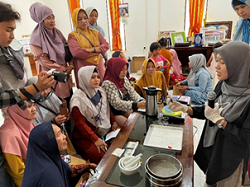Pengolahan Ampas Kopi Arabika (Coffea arabica L.) menjadi Masker Face Pack Powder di Desa Punggur Besar, Kuburaya Processing of Arabica Coffee Dregs (Coffea arabica L.) into Face Pack Powder Masks in Punggur Besar Village, Kuburaya
Main Article Content
Abstract
Cosmetics are preparations that are popularly used. Face pack is claimed to rejuvenate the skin and remove dirt and excess oil on the skin. Coffee grounds in Punggur Besar Village have only been thrown away and become waste, so a new breakthrough is needed to process coffee grounds so that they can be utilized and not wasted. This PKM activity will be carried out offline using the Health protocol. The purpose of the Community Service Program (PKM) is product innovation by utilizing coffee grounds waste into masks. This PKM activity began with making masks in the laboratory, training activities for making coffee grounds face packs including exposure of material on cosmetic face pack powder treatments, training with health protocols with the number of participants limited to 20 people with a room capacity of 50 people, exposure on labels and face packaging. pack powder, discussion and question and answer. Evaluation and monitoring activities are carried out using a questionnaire (pretest and post-test). The results of the activity showed significant differences in the results of the questionnaire analysis before and after the activity on each question item. The PKM activity targeting PKK women in Punggur Besar Village succeeded in increasing the ability of PKK women in utilizing coffee grounds waste into face pack powder masks. The next activity is expected to be able to provide assistance so that the resulting product obtains a distribution permit so that the coffee grounds face pack powder product can be marketed with a wider market share.
Downloads
Article Details

This work is licensed under a Creative Commons Attribution-ShareAlike 4.0 International License.
Authors who publish with this journal agree to the following terms:
- Any article on the copyright is retained by the author(s).
- Author grant the journal, right of first publication with the work simultaneously licensed under a Creative Commons Attribution License that allows others to share work with acknowledgment of the work authors and initial publications in this journal.
- Authors are able to enter into a separate, additional contractual arrangements for non-exclusive distribution of published articles of work (eg, post-institutional repository) or publish it in a book, with acknowledgment of its initial publication in this journal.
- Authors are permitted and encouraged to post their work online (e.g., in institutional repositories or on their websites) prior to and during the submission process, as can lead to productive exchanges, as well as earlier and greater citation of published work.
- The article and any associated published material is distributed under the Creative Commons Attribution-ShareAlike 4.0 International License
References
Acevedo, F., Rubilar, M., Scheuermann, E., Cancino, B., Uquiche, E., Garcés, M., et al. (2013). Bioactive compounds of spent coffee grounds, a coffee industrial residue. In Symposium on Agricultural and Agroindustrial Waste Management III. Sao Pedro, March 12-14. 1-4.
Agustiningsih, S. T. W. & Dwiyanti, S. (2017). Pemanfaatan Ampas Kopi dan Biji Kurma Dalam Pembuatan Lulur Tradisional Perawatan Tubuh Sebagai Alternatif Green Cosmetics. Jurnal Tata Rias, 6(1), 41-50.
Galeri, T., Astuti, D., & Barlian, A. A. (2017). Pengaruh Jenis Basis CMC-Na terhadap Kualitas Fisik Gel Ekstrak Lidah Buaya (Aloe vera L.). Parapemikir : Jurnal Ilmiah Farmasi, 4(1), 25–29. http://dx.doi.org/10.30591/pjif.v4i1.290
Górnas, P., Siger, A., Pugajeva, I., Czubinski, J., Waśkiewicz, A., & Polewski, K. (2014). New insights regarding tocopherols in Arabica and Robusta species coffee beans: RP-UPLC-ESI/MSn and NP-HPLC/FLD study. Journal of Food Composition and Analysis, 36(1-2), 117–123. https://doi.org/10.1016/j.jfca.2014.08.005
Jeszka-Skowron, M., Zgoła-Grześkowiak, A., & Grześkowiak, T. (2014). Analytical methods applied for the characterization and the determination of bioactive compounds in coffee. European Food Research and Technology, 240, 19-31. https://doi.org/10.1007/s00217-014-2356-z
Juliantari, N. P. D., Wrasiati, L. P., & Wartini, N. M. (2018). Karakteristik Ekstrak Ampas Kopi Bubuk Robusta (Coffea canephora) pada Perlakuan Konsentrasi Pelarut Etanol dan Suhu Maserasi. Jurnal Rekayasa dan Manajemen Agroindustri, 6(3), 243-249.
Kiattisin, K., Nantarat, T., & Leelapornpisid, P. (2016). Evaluation of antioxidant and anti-tyrosinase activities as well as stability of green and roasted coffee bean extracts from Coffea arabica and Coffea canephora grown in Thailand. Journal of Pharmacognosy and Phytotherapy, 8(10), 182-192. https://doi.org/10.5897/JPP2016.0413
Muliyawan, D. &Suriana, N. (2013). A-Z Tentang Kosmetik. Jakarta: Elex Media Komputindo.
Sharma, G., Gadhiya, J., & Dhanawat, M. (2018). Textbook of Cosmetic Formulations. Bangalore: Pothi.
Somwanshi, S. B., Kudale, K. S., Dolas, R., & Kotade, K. B. (2017). Formulation and Evaluation of Cosmetic Herbal Face Pack for Glowing Skin. International Journal of Research in Ayurveda and Pharmacy, 8(3), 199-203. http://dx.doi.org/10.7897/2277-4343.083199
Stalmach, A., Steiling, H., Williamson, G., & Crozier, A. (2010). Bioavailability of chlorogenic acids following acute ingestion of coffee by humans with an ileostomy. Archives of Biochemistry and Biophysics, 501(1), 98–105. https://doi.org/10.1016/j.abb.2010.03.005
